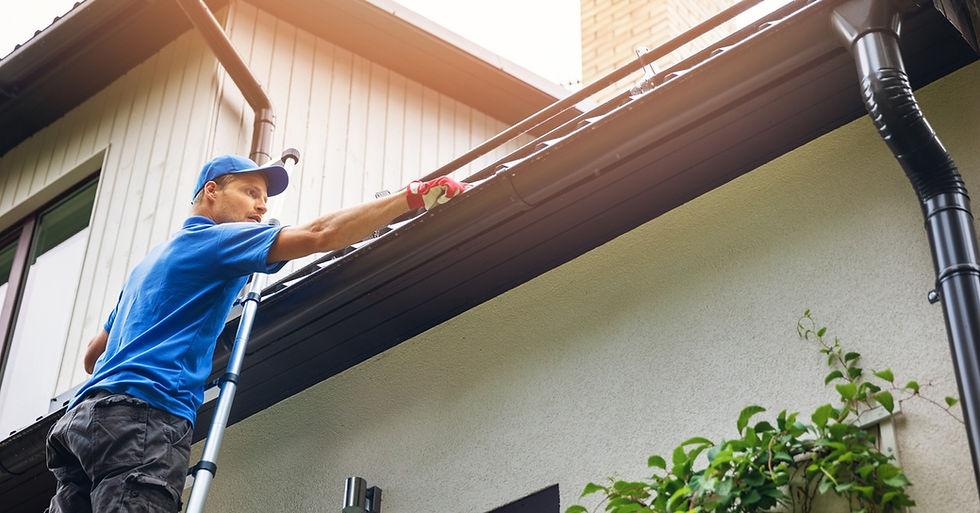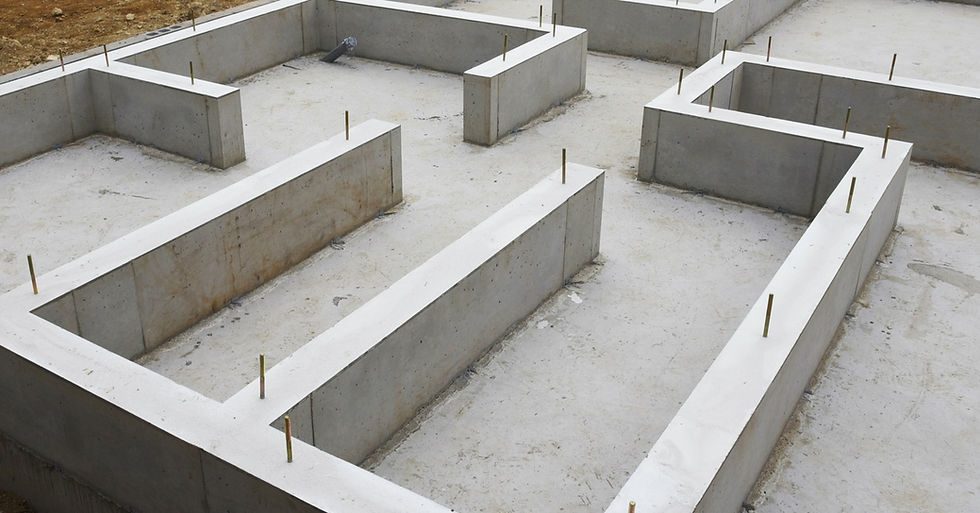A Complete Guide to the Different Types of Home Foundations
- Victoria Scott
- Mar 12
- 5 min read
Updated: Apr 8

Are you planning to build a new home or renovate your current one? If so, this complete guide to the different types of home foundations is crucial. A home’s foundation isn’t just its base—it’s what provides the support and stability for the entire structure, making it one of the most critical components of any residential build. The right foundation ensures your home can withstand environmental conditions, soil movement, and the passage of time. Consider the following for your new home build or renovation project.
Concrete Slab
Modern construction processes commonly use a concrete slab foundation, or a “slab-on-grade,” for residential builds. Installing this foundation involves pouring a thick, flat layer of concrete directly onto the ground to serve as your home’s base. This method is simple, cost-effective, and works well in areas with stable, dry soil and mild climates.
The benefits of a concrete slab foundation include its affordability and low maintenance. Moisture buildup and pest risks are fewer as this foundation type doesn’t include a crawl space or basement. However, this type of foundation doesn’t offer additional storage space, and repairing issues, such as cracks or plumbing, can be tricky and expensive.
Basement
A basement foundation involves excavating a hole below the frost line, pouring concrete walls, and then building the home on top. This type of foundation provides structural stability and offers additional living space or storage. Basements are particularly popular in areas prone to extreme weather, as they can double as storm shelters.
While basements provide extra functionality, they can be more expensive to construct. They also require effective waterproofing to avoid issues with moisture or flooding, especially in areas with high water tables. Despite these challenges, a basement foundation is a great option for homeowners seeking extra usable space.
Crawl Space
Like a basement foundation, a crawl space foundation creates a shallow space beneath the house. This area raises the home off the ground, providing ventilation and access to plumbing, wiring, and other utilities. Crawl spaces are particularly useful in sloped terrains or areas prone to flooding.
Although crawl space foundations offer practical benefits, they can be more costly than concrete slab foundations. Proper insulation and ventilation are also essential to prevent moisture buildup, mold, and pest infestations. Nonetheless, a crawl space can be a smart choice for homes built on uneven terrain.
Pier and Beam
A pier and beam foundation uses multiple columns or piers to support the structure instead of continuous walls. Contractors space out the concrete or wood piers under the house to create a sturdy and elevated base.
This type of foundation is ideal for homes located in flood-prone areas or regions with unstable soil. It also provides easy access to plumbing and electrical systems for repairs or upgrades. However, pier and beam foundations can be susceptible to sagging over time and may require periodic maintenance to stay level.

Stone
Stone foundations were widely used before modern building techniques became popular. This foundation type involves carefully stacking cut stone blocks on top of each other to create a strong and durable structure. Stone foundations have a charming, rustic appearance and are more common in older homes.
While they offer excellent stability, stone foundations can be prone to water damage and require regular maintenance, such as repointing (repairing mortar joints). Despite their challenges, stone foundations remain a solid choice for historic restoration projects or homeowners seeking a timeless aesthetic for their homes.
Brick
Brick foundations, like stone foundations, are common in older homes. This foundation type involves stacking bricks in a systematic pattern to create walls that support the structure. Brick foundations have incredible strength, stability, and traditional appeal.
However, like stone foundations, they can be vulnerable to moisture and water damage. Regular inspections and maintenance are necessary to ensure their longevity. Brick foundations are common in historic homes and restoration projects.
Concrete Block
Concrete block foundations consist of stacked, hollow concrete blocks. These blocks are lightweight, easy to work with and provide good insulation. Contractors often use them when building homes with a basement or crawl space.
While concrete block foundations are straightforward to construct, they can be susceptible to cracking if the soil beneath shifts or settles. Steel reinforcement bars and proper drainage systems can mitigate these risks.
ICF
Insulated concrete form (ICF) foundations are an innovative option for energy-efficient homes. They involve stacking interlocking Styrofoam blocks, which contractors then fill with concrete. This combination provides excellent insulation, reducing energy costs and enhancing comfort.
The downside of ICF foundations is their higher cost compared to traditional methods. However, the investment can be well worth it for homeowners wanting to prioritize energy efficiency and sustainability.
Screw Pile
Screw pile foundations are gaining popularity due to their quick installation process and minimal environmental impact. These foundations use large metal screw piles that go into the ground to support the structure. They are ideal for remote locations, environmentally sensitive areas, or sites with unstable soil. You’ll often see them in:
Smaller homes
Cabins
Modular buildings
Screw pile foundations offer flexibility and durability, but they may not be suitable for very large or heavy structures, so keep this fact in mind when it comes time to build your home.
Pile
Pile foundations are common when the soil is too weak to support the structure or when the building must transfer its weight into deeper, more stable layers of soil. This process involves driving long steel or concrete columns, called piles, deep into the ground.
Pile foundations are ideal for high-rise buildings, bridges, or homes in flood-prone areas. While they are highly effective, they require specialized equipment and can be costly to install.

Combination
Combination foundations combine two or more types to adapt to specific building requirements. For example, a hybrid foundation might use pier and beam for the main house and a basement for additional storage.
This approach allows for greater flexibility, but it also requires careful planning and coordination to ensure all components work together seamlessly.
Choosing the Right Foundation for Your Home
Selecting the right foundation for your home depends on soil conditions, climate, budget, and personal preferences. It’s always a good idea to consult a professional contractor or structural engineer to determine the best option for your specific needs. Remember, your home’s foundation is its literal and figurative base—choosing wisely can save you time, money, and stress in the long run.
Refer to this complete guide to the different types of home foundations to properly build or renovate your home. Each foundation type has its advantages and disadvantages, so it is important to carefully consider all factors before deciding. Omega Construction of MI can also help you with anything and everything regarding your home’s foundation. Omega Construction is here to take care of you and your home, whether you’re looking for foundation work or Ann Arbor basement repair!




Comments